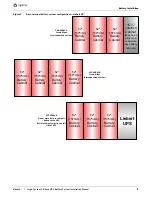
Mechanical Installation
Vertiv
|
Large System, 3-Phase UPS Battery System Installation Manual
3
1.0 MECHANICAL INSTALLATION
1.1
I
NTRODUCTION
This following section describes the requirements that must be taken into account when planning the
positioning and cabling of the Liebert battery equipment.
This chapter is a guide to general procedures and practices that should be observed by the installing engineer.
The particular conditions of each site will determine the applicability of such procedures.
NOTICE
Risk of improper startup. Can cause voiding of warranty and equipment damage.
Do not apply electrical power to the UPS equipment before the arrival of the commissioning engineer.
1.2
P
RELIMINARY
C
HECKS
Before installing the battery equipment, perform the following preliminary checks:
• Visually examine the equipment for transit damage, both internally and externally. Report any damage to the shipper
immediately.
• Verify that the correct equipment is being installed. The equipment supplied has an identification tag inside the main door.
• Verify that the battery room satisfies the environmental conditions stipulated in the equipment specification, paying
particular attention to the ambient temperature and air exchange system.
1.3
E
NVIRONMENTAL
C
ONSIDERATIONS
1.3.1
Battery Room
Batteries should be installed in an environment where the temperature is consistent and even over the whole
battery. Temperature is a major factor in determining the battery life and capacity. Typical battery manufacturer
performance data are quoted for an operating temperature between 68 and 77°F (20 and 25°C). Operating
above this range will reduce the battery life while operation below this range will reduce the battery capacity.
Battery Temperature
In a normal installation, the battery temperature should be kept between 59 and 77°F (15°C and 25°C).
1.3.2
Storage for Delayed Installation
If the equipment will not be installed immediately, it must be stored indoors in a clean, dry and cool location (see
in
). If the UPS includes batteries, either internally or in a battery cabinet,
the batteries’ requirements will dictate the storage conditions. Batteries should be unpacked, installed and
charged as soon as possible after delivery.
NOTICE
Risk of failure to properly charge batteries. Can cause permanent damage to batteries and void the warranty.
Batteries will self-discharge during storage. Batteries must be recharged as recommended by the battery manufacturer.
A notice of “Charge Before Date” is affixed to each unit that has batteries inside. The “Charge Before Date” is calculated
based on the batteries being stored at 77°F (25°C). Storage at a higher temperature will increase the rate of self-discharge,
requiring earlier recharge. Consult the battery manufacturer on how to determine when the batteries need to be
recharged.
NOTE
Battery cabinets are convection-cooled. Keep batteries away from main heat sources, main air inlets and similar
heating, ventilation and cooling features. These can cause inconsistent temperatures in sections of the batteries
and reduce either battery life or capacity.
Summary of Contents for Liebert NXL 1100
Page 2: ...Liebert Large System 3 Phase UPS Battery System Installation Manual...
Page 69: ...Specifications Vertiv Large System 3 Phase UPS Battery System Installation Manual 62 NOTES...
Page 70: ...Specifications Vertiv Large System 3 Phase UPS Battery System Installation Manual 63...
Page 71: ...Specifications Vertiv Large System 3 Phase UPS Battery System Installation Manual 64...











































